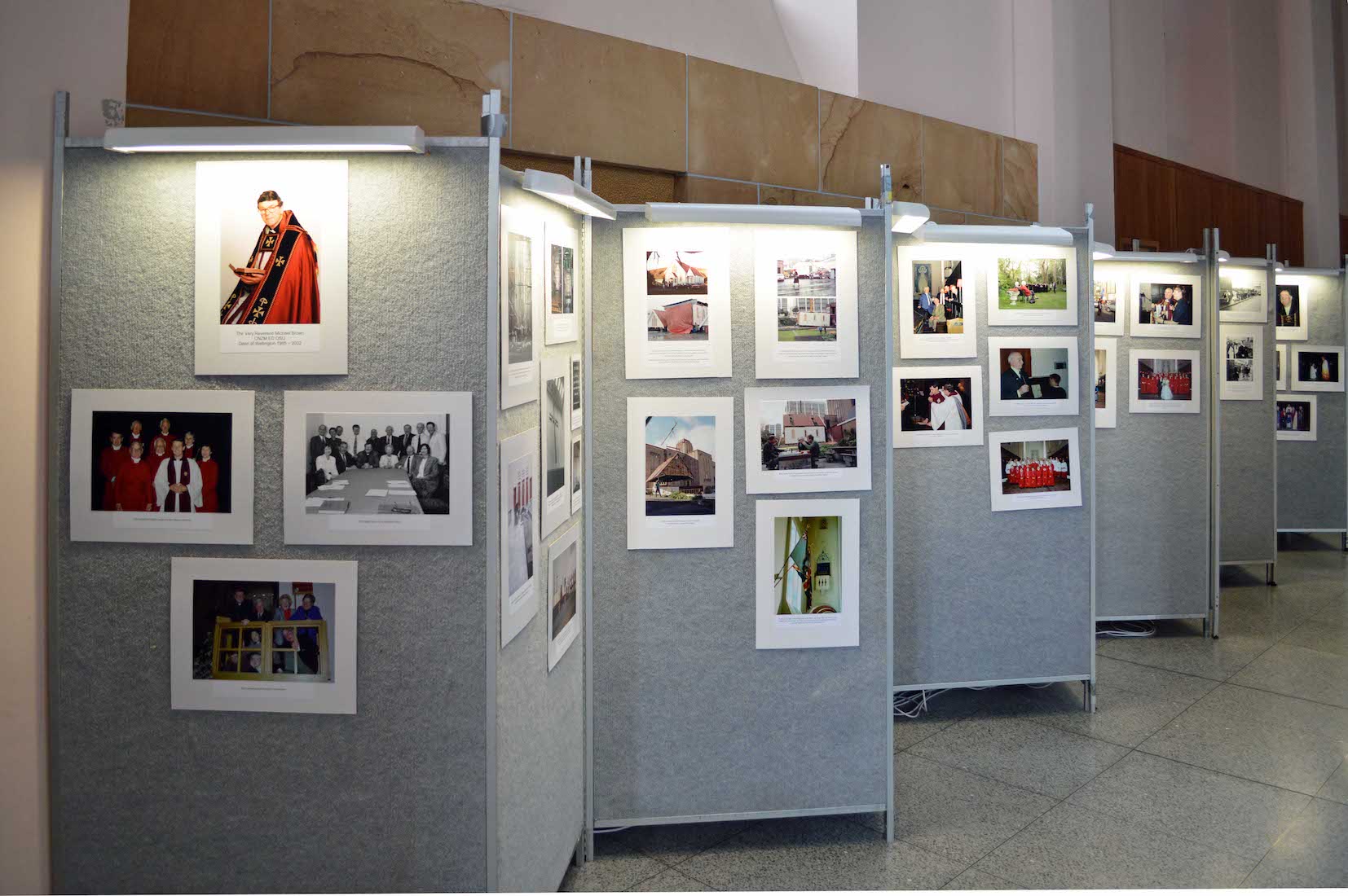
Looking back West in the nave we observe the balcony above the narthex, and the unusual cross above. The elusive flag room is not in sight, being above the ceiling line. Access is from the doors at the back of the gallery. PLAN
22. CANDLE AND FONT

We return to the back of the nave where the Paschal candle and font sit beside the main entrance. In cathedrals, the font is often placed by the entrance, as baptism is closely associated with entry into the Christian life and the church. The angels are keeping watch ... .
23. BACK OF NAVE
Looking to the North from here we notice the flags hanging, a small ‘chapel’ directly ahead, and a memorial at right.
24. REGIMENTAL COLOURS
There are three ‘flags’ hanging from horizontal poles on either side of the nave at the rear. There is a tradition in many cathedrals for regimental colours to be displayed, particularly of regiments which have been disbanded. Sometimes the colours become quite tatty ... .
25. CHAPEL WITHOUT WALLS
This is a place for those who wish to pray or light a candle. A lighted candle can be an evocative symbol of prayer. Prayers may also be written down; these are followed up at the next Communion service in the Lady Chapel.
26. NORTH NAVE AISLE
What shall we find next? There is a clear window and then (in fact) three stained glass windows. Below is a memorial (at left), and a large display of photos celebrating the 50 years of Cathedral history from 1964.
27. PLACE OF MEMORY
The white stone in the centre was taken from the memorial at Gallipoli, Turkey. Chunuk Bair was captured from the Turks by the Wellington Batallion in August 1915.
28. NORTH NAVE WALL
We next explore the North nave windows, and investigate the display below.
29. NORTH NAVE WINDOWS
The windows are high and detailed, and we need to look more closely to see their significance. From left they show: • St Paul’s conversion and his speech to the people of Athens; • three earlier visionaries – Isaiah, Jeremiah and Ezekiel; • Jacob the Patriarch who wrestled with an angel, Moses the law giver, and David the hero King.
30. NORTH AISLE
This different view of the North aisle is interesting because it shows how it continues on as the North ambulatory alongside the chancel and sanctuary.
31. DISPLAY
The display boards contain various photographs pertaining to the last 50 years in the life of St Paul’s. Each photograph has a short explanatory comment beneath.
32. DISPLAY CLOSE UP
As an example, this board displays photographs of Dean Frank Nelson and his wife Christine. Frank was Dean from 2004 to 2012, before accepting the post of Dean at St Peter’s Cathedral, Adelaide.
33. CROSSING
Without a double transept, St Paul’s hardly has a crossing, but this is the space between nave and chancel, looking North. There is a small lit up cabinet display, the Holm window above access doors through to the refectory, and the pulpit at right.
34. CABINET DISPLAY
In this cabinet are displayed various documents and items relating to the Cathedral, including an historic trowel.
35. HOLM WINDOW
This window is dedicated to Captain Ferdinand Holm, founder of the Holm Shipping Company. It depicts St Paul, patron saint of this Cathedral, and thought of here as the missionary voyager. The window shows the Southern Cross, the flag of the shipping line, and three ships of the line in tumultuous seas.
36. PULPIT
The pulpit is constructed from solid slabs of marble. It is from here that the Christian message is expounded week by week.
37. LECTERN
Directly across from the pulpit stands the lectern. It is from here that the Word of God is read during Cathedral services..
38. SOUTH AISLE DISPLAYS
As we continue our exploration of the nave, we move to the South aisle. Here there is a continuation of the display boards with their photographs.
39. SOUTH NAVE WINDOWS
The South nave windows depict (from left): • the Nativity; • the Crucifixion and the Resurrection; • the church in action and instruments of worship. The nave windows were made by Whitefriars of London. There are five windows on this wall, but two of them are clear.
40. TRIBUTE
As we move West up the South nave aisle we come to this National Tribute to the Women of New Zealand. The sign relates to the adjacent artwork ...



















